If you are looking for ways to build up your traps and search for the best trap exercises, then you are in the right place. Here, you will explore the best trap exercises to build trapezius muscle.
If you ignore your traps and fail to strengthen them along with the other muscles in your back, it can lead to poor posture, decreased performance, and even injury down the line.
And doing a trap workout has many advantages, like better posture and better performance.
But what are the best trap exercises? Which exercises for traps should you include in trap workouts for strength, hypertrophy, and endurance?
This blog contains detailed descriptions of all major exercises focusing on the trap muscles, including the upper, middle, and lower trapezius muscles.
In this ultimate guide, we’ll take you through everything you need to know:
- Anatomy of the Trap Muscles
- How To Do Trap Workout
- 20 Best Traps Exercises
- The Benefits of Strong Traps
- How to Train Upper, Mid and Lower Traps
- How To Add Trap Exercises Into Your Workout Routine
- Trap Workout Routine Plans
- FAQs
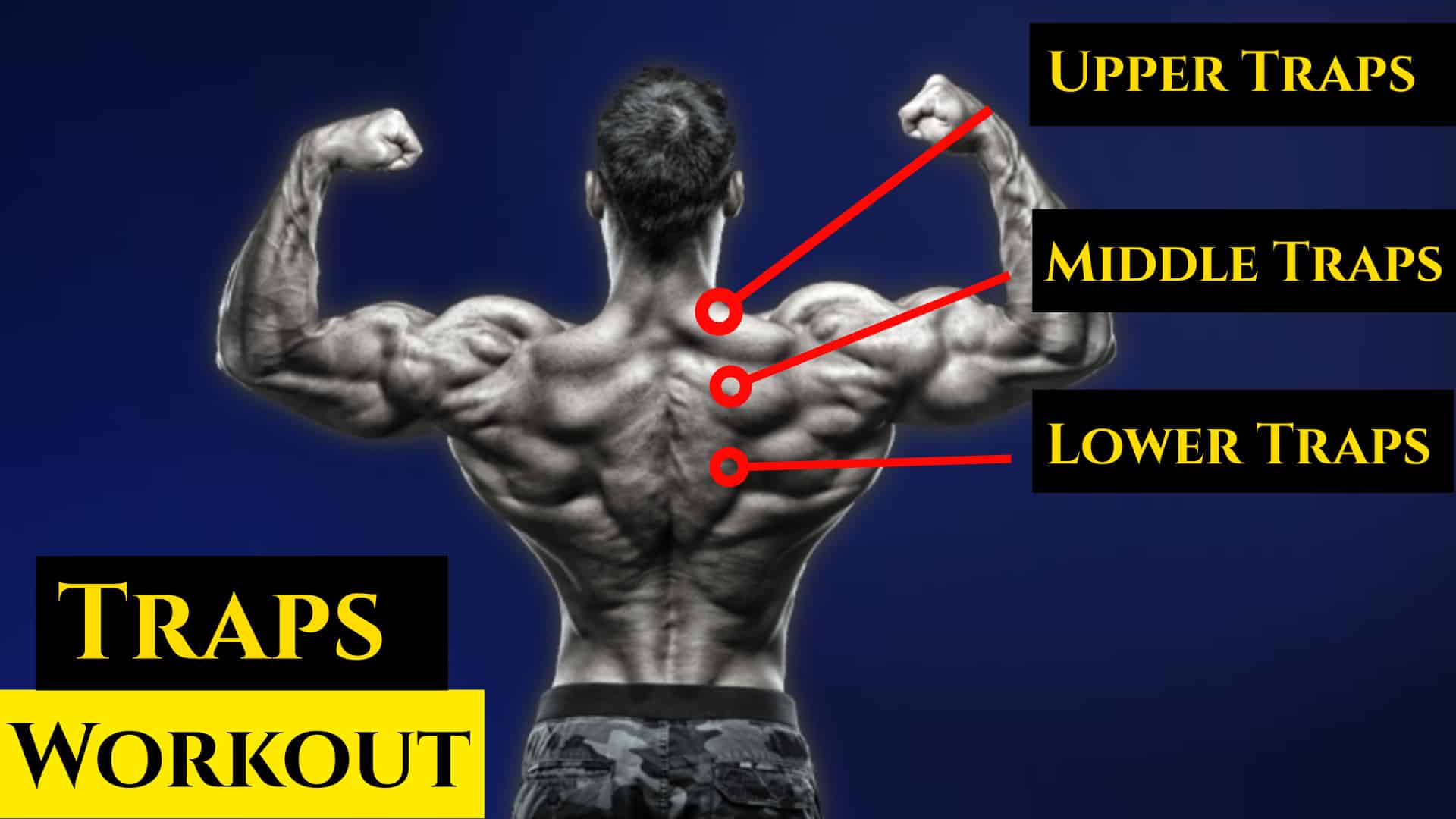
- What Exercises Work Traps
- Upper Trap
- Middle Trap
- Lower Trap
- How To Do Trap Workout To Build Mass and Strength
- 20 Best Trap Exercises To Build a Bigger Upper Back
- 1. Dumbbell Upright Row
- 2. Incline Dumbbell Shrug
- 3. One-Arm Dumbbell Upright Row
- 4. Incline Y-Raise
- 5. Bent Over Dumbbell Lateral Raise
- 6. Dumbbell Bent Over Row
- 7. Dumbbell Farmers Walk
- 8. Dumbbell Shrug
- 9. Barbell Shrug
- 10. Barbell Upright Row
- 11. Calf Raise Machine Shrug
- 12. Smith Machine Shrug
- 13. Behind-the-Back Barbell Shrug
- 14. Smith Machine Behind-the-Back Shrug
- 15. Bent Over Barbell Rows
- 16. T Bar Row
- 17. Face Pull
- 18. Cable Shrug
- 19. Cable Upright Row
- 20. Cable High Row
- Bonus: Wide-Grip Pull-Up
- The Benefits of Strong Traps
- 1. Improved Posture
- 2. Increased Strength
- 3. Reduced Neck Pain
- 4. Improved Shoulder Stability
- 5. Improved Athletic Performance
- 6. Enhanced Upper Body Aesthetics
- 7. Reduced Risk of Shoulder Injuries
- Important Function Of Trap Muscle
- How to Train Upper, Mid and Lower Traps
- How To Train Upper Traps
- How To Middle Traps Workout
- Train Lower Traps
- How To Incorporate Trap Exercises Into Your Workout Routine
- 1. Add the Optimum No. Of Sets And Reps
- 2. During Workout Splits
- 3. During Your Shoulder And Upper Body Workout
- 4. Frequency
- Trap Workout Routine Plans
- Frequently Asked Question
- Do shrugs build traps?
- How do I build my trap muscles?
- How long does it take for traps to grow?
- How can I build my trapezius at home?
- Conclusion
- Reference
- 18 Best Trap Exercises For Mass And Strength
What Exercises Work Traps
Before starting trap training, it’s crucial to understand the anatomy of the trapezius muscles.
The trapezius muscle, aka trap muscle is one of the widest back muscles. The trapezius is called such because of its shape. It looks like a trapezoid (a shape with four sides, two that are parallel).
It is a large muscle that extends from the base of your skull down your spine and out to your shoulder blade. It’s responsible for moving, rotating, and stabilizing your scapula (shoulder blade) and extending your neck.
The trapezius muscle has three distinct regions:
- Upper Trapezius,
- Middle Trapezius,
- Lower Trapezius,
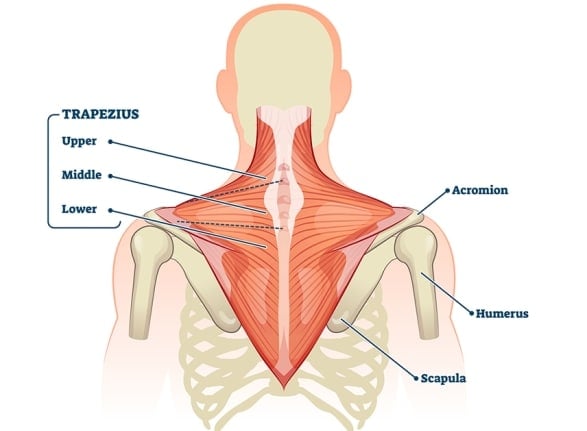
Upper Trap
The upper fibers of the trapezius muscle originate from the back of the skull and attach to the lateral third of the clavicle (collarbone).
The upper traps are responsible for elevating the shoulders and rotating them inward. They are worked primarily with shrugging movements.
Middle Trap
The middle fibers of the trapezius muscle originate from the spinous processes of the vertebrae in the upper back and attach to the acromion process of the scapula.
The middle traps are responsible for retracting the scapula (shoulder blades). They are worked with rowing movements.
Lower Trap
The lower fibers of the trapezius muscle originate from the spinous processes of the vertebrae in the middle and lower back and attach to the medial border of the scapula.
The lower traps are responsible for depressing the scapula and rotating them upward. They are worked with exercises that involve raising the arms overhead.
How To Do Trap Workout To Build Mass and Strength
The number of reps and sets will vary based on your fitness level, weekly workout frequency, and strength training goals to structure an effective trap workout to build increased mass and strength.
For strength gains, do 4 to 6 sets of 1 to 6 reps each exercise with a weight of at least 85% of your one-repetition maximum (1RM). The fewer reps you perform, the closer to 100% of your 1RM you should strive for.
If your goal is hypertrophy (muscle growth), perform three sets of each exercise, using loads that are 70 to 85% of your 1RM for 8 to 12 reps.
When training for endurance, it is usually recommended to use higher reps (15 to 20 repetitions) and moderate loads with a weight of at least 50 to 70% of your 1RM.
Want to take your gains to the next level? Discover your daily calorie needs with our free TDEE calculator
20 Best Trap Exercises To Build a Bigger Upper Back
The trap exercises are divided into barbell and Smith machine shrugging exercises, dumbbell shrugging exercises, upright row, cable face pull, and high cable row.
Now, let’s get into the best trap exercises for mass and strength using various types of fitness equipment.
1. Dumbbell Upright Row
The dumbbell upright row is a compound exercise that builds stronger and bigger traps and rear deltoids (back side of shoulder).
Dumbbells in the upright row can help increase unilateral muscle development and address any imbalances in asymmetries and movement.
The standing DB upright row can be done with different grip widths.
- Close or narrow grip (half of the shoulder width),
- A standard grip (shoulder-width grip)
- A wide grip (wider than the shoulder)

How To Do
- Hold the dumbbells at arm’s length down by your thighs with your palms facing towards you.
- Your grip should be just less than shoulder width.
- Lift the dumbbell and get it as close as possible to the chest height using your arms.
- Elevate your shoulders to squeeze your trapezius muscles.
- Now, lower the dumbbell under controlled motion until it returns to its starting position.
- Repeat for the desired number of reps.
Tips
- Remember to exhale while you exert.
- Keep a controlled motion and avoid jerky movements.
- Don’t allow your back to arch as you pull the weight up.
Know More: Upright Row: Muscle Worked, Form, Benefits, Variations
2. Incline Dumbbell Shrug
The Incline dumbbell shrug is a variation of dumbbell shrug exercises that strengthen the upper trapezius and neck region and also help to improve posture.
This shrug variation will emphasize the upper traps and the upper portion of the middle traps.
The fact that your chest is pressed on the bench will make it difficult to use momentum to drive the weight up.

How To Do
- Grab a pair of dumbbells and straddle an adjustable-incline bench with your feet flat on the floor, or position them on the bench frame to support your body.
- Hold the dumbbells with a neutral grip at your sides and lie chest-down on an incline bench.
- Slowly shrug your shoulders up toward your ears.
- At the top, pause momentarily and contract hard through your traps and rhomboids.
- Slowly lower the weights back to the starting position.
Tips
- Keep your arms straight throughout the entire movement.
- Avoid using extremely heavy weights.
- Move the dumbbells smoothly and evenly without jerking them at all.
3. One-Arm Dumbbell Upright Row
One arm dumbbell upright row is the unilateral variation on the dumbbell upright.
It is a popular movement for building stronger and bigger traps and shoulders.
This also helps to prevent muscle imbalances and improve the overall strength and symmetry of the muscles.

How To Do
- Stand with your feet shoulder-width apart. Hold a dumbbell in your left hand at your side.
- Slowly shrug your left shoulder up toward your ear.
- At the top, pause for a moment and contract the muscles.
- Slowly lower the weight back to the starting position.
- After completing all reps on the left side, repeat on the right side.
- Repeat for the desired number of repetitions.
Tips
- Keep a controlled motion and avoid jerky movements.
- Keep your back straight and core tight.
- Pause and squeeze the traps at the top of the movement.
4. Incline Y-Raise
Y Raises are a great and easy-to-do shoulder stability exercise that targets both the rotator cuff muscles and your lower traps.
The incline Y raise is useful in your routine as it targets the shoulders and back and helps tone and strengthen your upper body.
The Y Raise is usually done on an incline bench, but it can be done in various ways.
- Standing Y-Raise, on the floor Y-raise,
- Y-raise on a flat bench
- Y-Raise on Swiss ball
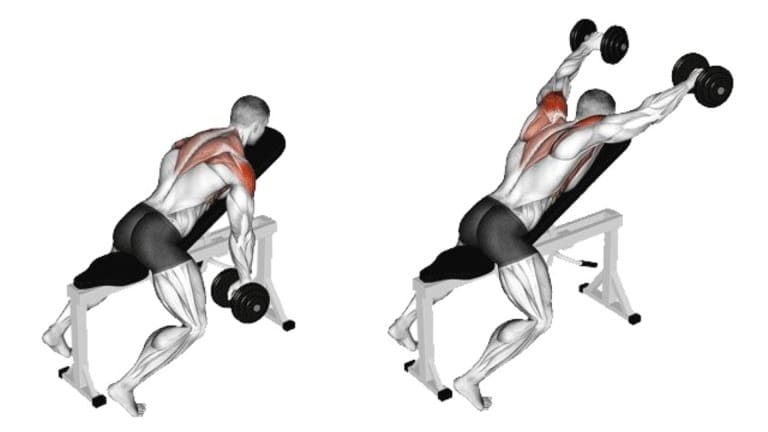
How To Do
- Lie face down on an incline bench with your chin past the end of the bench.
- Hold two light dumbbells or weight plates.
- Lift both dumbbells up as high as possible while forming a letter Y with your arms and torso.
- Hold this position for two seconds before returning the dumbbells to the starting position.
- Repeat for the desired number of repetitions.
Tips
- Raise your arms slowly and controlled.
- Be careful not to use too much weight, as it is very easy to injure your deltoids.
5. Bent Over Dumbbell Lateral Raise
Bent over raises are excellent for isolating and working on rear deltoid muscles. It also incorporates the middle and lower trapezius, the rhomboids, and parts of the rotator cuffs.
There are many variations of bent-over lateral raise that you can add to your workout routine, and all have their own unique benefits.
- Dumbbell Bent Over Raise: Enhances shoulder stability with free weights.
- Cable Rear Delt Lateral Raise: Constant tension for efficient muscle activation.
- Incline Bench Rear Raise: Increases stretch and contraction for rear delt development.
- One-Arm Rear Bent Over Raise: Improves symmetry and targets rear deltoid isolation.

How To Do
- Sit at the end of a bench with a pair of dumbbells.
- Bend forward and let the dumbbells hang on your sides.
- Lift the dumbbells, raising them on your sides to a level slightly uppermore than your shoulders.
- Now lower the dumbbells back to your sides.
Tips
- Your arms should be parallel to your shoulders.
- Keep strict form to isolate the rear delts.
6. Dumbbell Bent Over Row
If you want to strengthen your back and trap muscles, bent over dumbbell rows are the exercise for you.
It is a strength training exercise that targets the upper back muscles, including the trapezius, rhomboids, and latissimus dorsi.
Here is a simple way to target your muscles.
- Pulling the dumbbell up higher toward the chest targets the upper latissimus and trapezius.
- Pulling the dumbbell through a lower trajectory to touch the abdomen targets the lower lats.

How To Do
- Stand with a narrow stance and a dumbbell with a neutral grip in each hand.
- Bend your torso forward at an angle of 45 degrees to the floor with your knees slightly bent.
- Use the back and raise the dumbbell until it touches the abdominal region.
- Slowly lower the dumbbell, keeping it in control of the starting position.
Tips
- Do not use more weight than you can handle. This fatigues your spinal erectors and says goodbye to form.
- Keep movement always under control without letting gravity take you down faster.
7. Dumbbell Farmers Walk
The farmer’s walk exercise, also called the farmer’s carry, is a strength and conditioning exercise in which you hold a heavy load in each hand while walking for a designated distance.
It might be one of the classic exercises and a move that men have been doing since the beginning of time.
The Farmer’s Walk allows you to accomplish much in a single exercise.

How To Do
- Reach down, bending at the hips and knees, and grasp the dumbbells in each hand.
- Hold the dumbbells at your side with a firm grip.
- Stand tall, keeping your shoulders, back, and core tight.
- Take small steps and walk forward at an even pace with your eyes focused straight ahead of you.
- Complete the desired number of steps, come to a stop, and place the dumbbells down.
Tips
- Focus on squeezing your shoulder blades and tightening your abs.
- Keep a neutral or straight spine throughout the movement to avoid injury.
8. Dumbbell Shrug
The dumbbell shrug is great for building bigger and stronger trapezius muscles. It is an isolation exercise that targets the upper trapezius muscle.
It is a simple yet effective exercise that strengthens the shoulders, upper back, and neck muscles. Dumbbell shrugs are suitable for both beginners and pros because they can be performed with various weights.
This exercise can be done with a medium to heavy dumbbell to increase the trap thickness, which will greatly help you do back poses.

How To Do
- Stand upright and keep your arms at your sides and with a dumbbell in each hand.
- Raise your shoulders as high as you can, as if trying to touch them to your ears.
- Hold at the top for a moment, then release and return to the starting position.
- Repeat the movement for the desired number of repetitions
Tips
- Try not to move anything but your shoulders.
- Inhale when you lower the weight and exhale when you lift.
- Adding a pause at the top of the movement can help to enhance the mind-muscle connection.
- Limit momentum and excessive jerking or bouncing of the weight.
Read More To Know More: Shrug Exercise: Benefits, Variations, Muscles Used, Tips
9. Barbell Shrug
Barbell shoulder shrug is a popular exercise choice for strengthening your trapezius, upper back, shoulder muscles, neck, and upper arms.
It is one of the best exercises to increase upper back and shoulder hypertrophy when practiced consistently.
A study has shown that shrugging helps relieve shoulder and neck pain. Strengthening your traps helps provide better support to your head and neck by increasing the activation of your shoulder muscles.
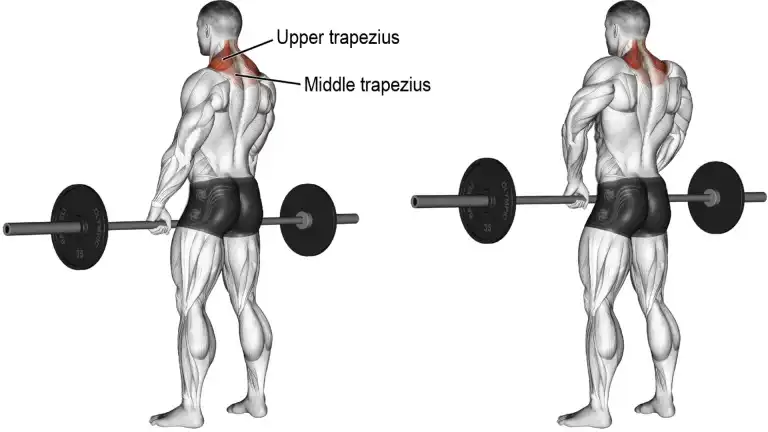
How To Do
- Stand with feet placed shoulder-width apart, knee slightly bent, and core stable.
- Grip the barbell with your hands facing downwards in a pronated grip.
- Raise your shoulders without bending your elbows as far as possible, getting them closer to your ears.
- Hold the contraction and squeeze for a brief second.
- In a controlled and stable manner, lower the weight back down to the starting position.
Tips
- Go as high as possible, but limit momentum and excessive jerking or bouncing of the weight.
- Go full range. Move only the shoulders and keep the rest of the body steady.
- Keep your arms straight and focus on lifting the weight with your shoulders, not your arms.
- Avoid rolling your shoulders forward or backward during the exercise.
10. Barbell Upright Row
The barbell upright row is an excellent exercise to build huge Trapezius muscles and create that deltopectoral separation.
Upright rows, along with shrugs, create massive traps. It can be done with both narrow grips and wider ones.
- The narrow grip focuses on the trapezius, and the wider one focuses on the entire shoulder girdle.
- Moreover, the wider grip allows some cheating movement, thereby allowing you to lift more weight.
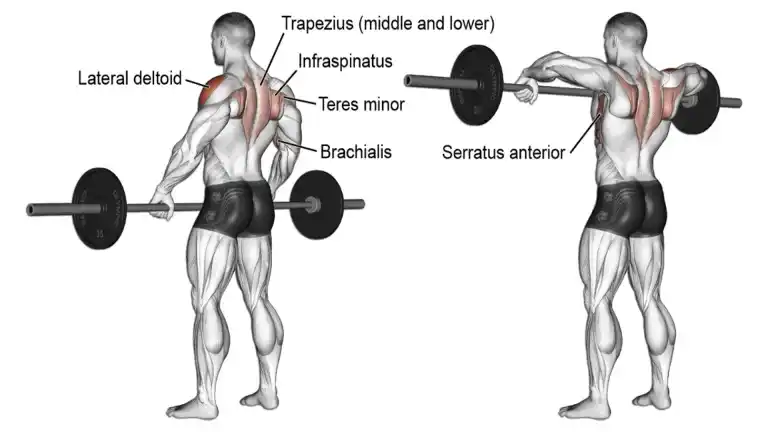
How To Do
- Hold a bar with a narrow overhand grip and let it hang before you.
- Lift the bar and get it as close as possible to the chin, using your arms and elevating your shoulders to squeeze your trapezius muscles.
- Now, lower the bar under controlled motion until it returns to its starting position.
- Repeat for desired reps.
Tips
- Focus on keeping your elbows higher than your forearms.
- Keep a controlled motion and avoid jerky movements.
- Keep your back straight while you do this.
11. Calf Raise Machine Shrug
The gripless shrug is a great alternative to the traditional one. The traditional shrug requires both hands to hold the weight, whereas the gripless shrug eliminates the need for additional grip strength.
It is a very effective isolation exercise for the trapezius muscles.
This is because you don’t have to depend on your grip strength to work the traps effectively.
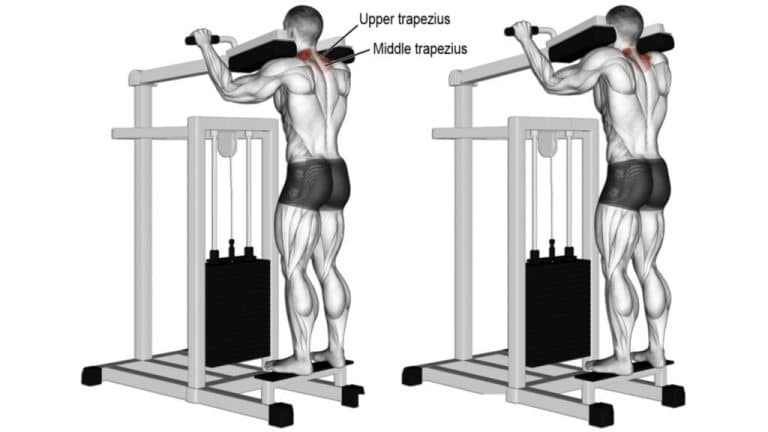
How To Do
- Stand inside the standing calf raise machine with your shoulders under the pads.
- Grab the handles for stability, although this isn’t necessary.
- Exhale as you slowly raise your shoulders as high as you can.
- Hold for a count of two. Inhale as you slowly lower your shoulders to the starting position.
- Repeat for the desired number of repetitions.
Tips
- Keep your back straight and core tight.
- Avoid using a weight that is too heavy because it will limit your range of motion.
12. Smith Machine Shrug
The Smith machine shrug is a variation of the barbell shrug done on a Smith machine, a weight training machine with a barbell fixed to steel rails.
It allows for greater control over the weight as the barbell moves along a fixed path.
It is usually performed for moderate to high reps, such as 8-12 reps per set or more, as part of trap-focused training.
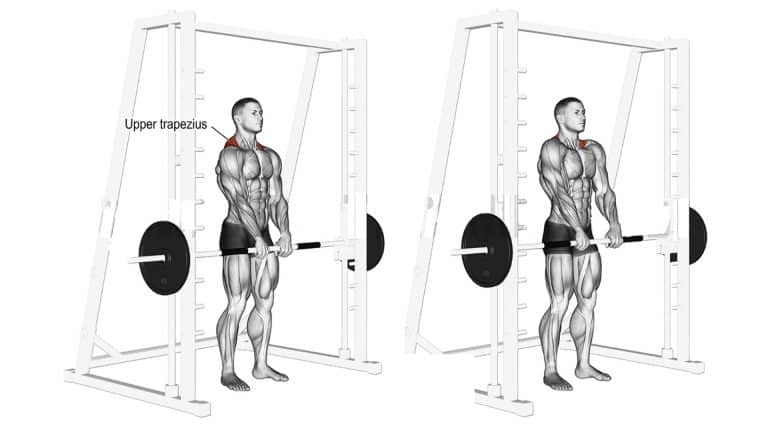
How To Do
- Stand in a Smith machine, holding the unlatched bar with an overhand grip in front of your thighs.
- Both your hands and your feet should be shoulder-width apart.
- Lift your shoulders up toward your ears as high as possible while keeping your arms straight.
- Hold the contraction for a second before lowering the bar back to the starting position.
- Repeat for the desired number of repetitions.
Tips
- Focus on lifting the weight with your traps and not your biceps.
- Pausing at the top of the barbell shrug makes the exercise more challenging and you’ll get more out of it.
- Do not roll your shoulders, which can lead to a shoulder injury.
13. Behind-the-Back Barbell Shrug
The barbell behind-the-back shrug is an exercise targeting the traps. Having the bar behind you helps keep your shoulders pulled up and back rather than rounded forward.
It provides variety to your workout routine and challenges the trap muscles differently.
It is popular in strength and muscle-focused upper-body training and is often trained on a shoulder day.
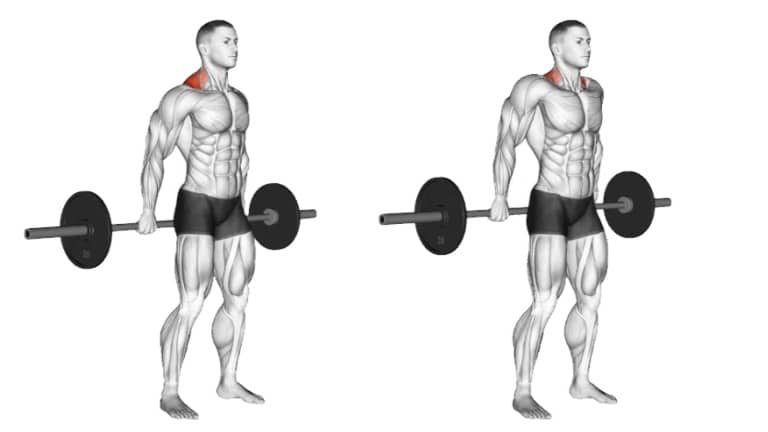
How To Do
- Stand while holding a barbell with an overhand grip behind your thighs.
- Keep both your hands and your feet to be shoulder-width apart.
- Lift your shoulders up toward your ears as high as possible while keeping your arms straight.
- Hold the contraction for a second before lowering the bar back to the starting position.
- Repeat for the desired number of repetitions.
Tips
- Maintain proper posture by keeping your chest lifted and shoulders pulled back.
- Keep your arms straight and focus on lifting the weight with your shoulders instead of your arms.
14. Smith Machine Behind-the-Back Shrug
The Smith machine behind-the-back shrug provides variation to your workout routine and challenges the trap muscles differently than the traditional barbell shrug.
The Smith machine has a fixed bar path that can help you maintain proper form and reduce the risk of injury.
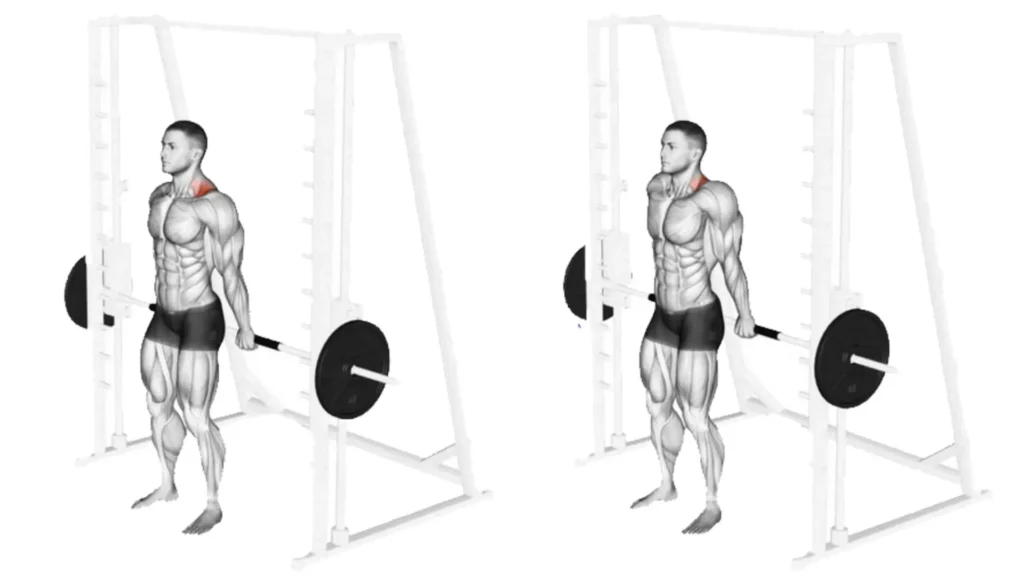
How To Do
- Stand in a Smith machine and hold the unlatched bar with an overhand grip on the back of your thighs.
- Lift your shoulders up toward your ears as high as possible while keeping your arms straight.
- Hold the contraction for a second before lowering the bar back to the starting position.
- Repeat for the desired number of repetitions.
Tips
- Focus on lifting the weight with your traps and not your biceps.
- Pausing at the top of the barbell shrug makes the exercise harder.
15. Bent Over Barbell Rows
The bent-over barbell row is a compound exercise that primarily targets the upper back muscles, including the latissimus dorsi, rhomboids, and traps.
- Keeping your hands shoulder-width apart or closer targets the inner section of the lats, trap, and rhomboid.
- A wider grip targets the outer lats and rear deltoid.
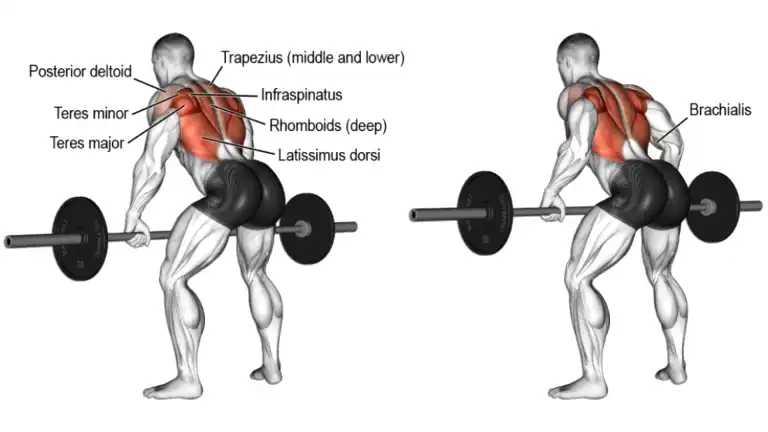
How To Do
- Stand with a narrow stance and grab a bar with an overhand grip.
- Bend your torso forward at an angle of 45 degrees to the floor with knees slightly bent and let the bar hang in front of you.
- Pull the barbell up towards your chest, keeping your elbows close to your sides.
- Slowly lower the bar under control to the starting position.
Tips
- Do not use more weight than you can handle.
- Exhale on pushing movement and inhale when returning to the starting position.
- Hold a neutral spine throughout the movement to prevent injury.
16. T Bar Row
T-bar’s row is most frequently incorporated into certain exercise routines that require significant hypertrophic muscle growth and neurological adaptation in the back muscles of the exerciser.
It is considered a compound movement type exercise because of the wide range of muscles activated by it.
Building a strong back is essential for developing a quality physique, staying injury-free, and avoiding back pain for life.
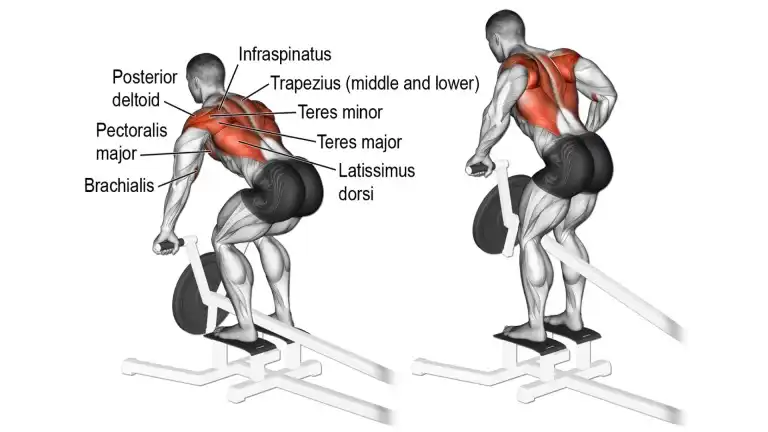
How To Do
- Standing on a T-bar machine, grab its handles with an overhand grip.
- Keep your feet a bit apart and knees slightly bent.
- Bend at the hips and keep your back arched throughout the movement.
- Lift the bar until it touches your chest, keeping the back straight.
- Now, slowly lower the bar until it nearly touches the ground.
Tips
- Exhale while you exert.
- Avoid hunchback bending as it leads to Injury.
- Go complete range of motion.
17. Face Pull
Face pull is a cable machine exercise that primarily targets the rear deltoid and traps to a lesser degree and also targets the biceps, triceps.
The face pull can help to prevent shoulder injuries by strengthening the rotator cuff muscles.
Face Pulls involve external rotation of the shoulders, which can contribute to maintaining healthy shoulder joint mechanics and reducing the risk of impingement.

How To Do
- Grab the ends of the rope attachment using a neutral grip (palms facing each other) and slightly lean back.
- Pull the rope toward your face as you spread the ends of the rope.
- Hold this position for as a second as you squeeze your shoulder blades together.
- Then, slowly return the rope to the starting position.
Tips
- Stand straight with your feet in a comfortable, balanced stance.
- Be sure to exhale when pulling weight toward your face.
- Think about trying to pinch your shoulder blades as tight as possible when pulling weight toward your face.
18. Cable Shrug
The cable shrug is one of the best exercises for isolating the traps and offers versatility for further improving development.
Cable shrugs provide constant tension throughout the movement, increasing muscle activation and promoting muscle growth.
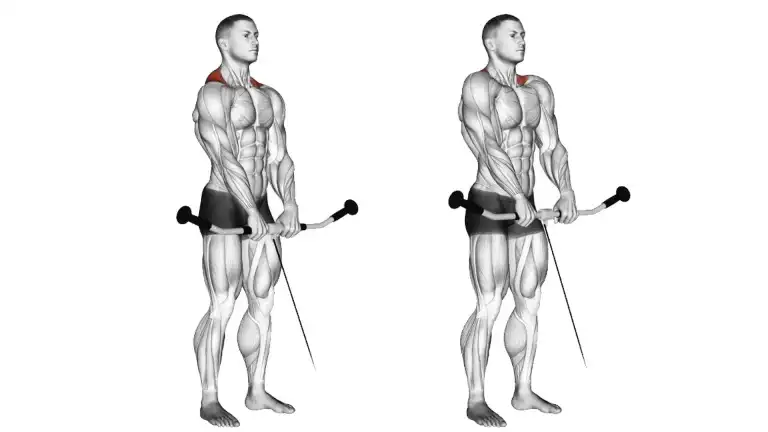
How To Do
- Grab a cable bar attachment that is attached to a low pulley.
- Your hands should be shoulder-width apart or slightly wider if you wish. Your hands should be facing down.
- Stand close to the pulley and extend your arms in front of you while holding the bar.
- Raise your shoulders and lift the bar as high as you possibly can. Exhale while performing this movement.
- Hold the contraction at the top for a second.
- Slowly lower the bar to its starting position.
- Repeat 10-12 reps.
Tips
- Prevent from rolling your shoulders, as this is an incorrect form and can result in injury.
19. Cable Upright Row
The cable upright row is a movement that targets many of the large muscles in the upper back and shoulders, which is key for many movements in strength, power, and fitness sports.
Upright rows are an exercise that nearly everyone can do using various grip widths.
Cable machines keep tension on the muscles throughout the entire range of motion, ultimately increasing muscle activation and hypertrophy.

How To Do
- Attach a straight bar to a low cable pulley.
- Grab the bar using a shoulder-width or wider overhand grip.
- Stand close to the pulley with your body upright, your shoulders pulled back.
- Exhale as you pull the bar up the front of your body until it reaches your lower or middle chest level.
- Do not pull the bar up any higher. Hold for a count of two.
- Inhale as you lower the bar to the starting position.
Tips
- Bend slightly at the knees and stand with feet shoulder-width apart.
- Keep your shoulders back, chest out, and body upright.
20. Cable High Row
Half kneeling high cable row rope is a tremendous exercise that effectively works many muscles, including the shoulder, back, wing, and trapezius muscles.
In addition, pulling exercise is one of the most effective corrective exercises that help compensate for poor posture and shoulder dysfunction.
Being kneeling will help stabilize your body so that you’re not leaning too far forward or backward.

How To Do
- Set the cable up at a high point with the rope attachments
- Grab the rope with both hands using an overhand grip.
- Then take a step back and get onto knees, facing the cable machine
- Starting with your arms stretched out and away, pull back through your elbows until your hands are just in front of your shoulders
- Slowly return to the starting position.
- Repeat for desired reps.
Tips
- Don’t lean backward to pull the weight towards you.
- Focus on the mind-muscle connection to pull down by using your back muscles.
Bonus: Wide-Grip Pull-Up
The wide-grip pull-up is harder to perform than a standard pull-up because your hands will be further away from the center of your body, making the exercise more difficult.
The wide grip pull-up increases your back’s strength, thickness, and width, specifically your lats. The lats are what influence back width and form the “V” in the upper back.

How To Do
- Using an overhand grip, grab onto a pull-up bar with your hands spaced wider than shoulder-width apart.
- Hang on the bar with your arms fully extended and your chest high while exaggerating the arch in your lower back.
- Pull yourself up by squeezing your shoulder blades together and contracting your lats until your chin passes the bar.
- Hold the contraction at the top for a second before slowly lowering yourself back to the starting position.
Tips
- To decrease bicep involvement, use a thumbless grip.
- Go full range of motion and keep form correct. Avoid jerky movements and keep them controlled.
Related Post: 25 Different Types Of Pull Ups And Chin Ups (Variations)
The Benefits of Strong Traps
Having strong and well-developed traps can lead to several benefits.
1. Improved Posture
One of the primary benefits of trap exercises is improved posture. Trap exercises significantly improved forward head posture, a common postural issue attributed to prolonged sitting and poor posture.
2. Increased Strength
Trap exercises have been shown to increase strength in the upper back and neck muscles.
A study published in the Journal of Strength and Conditioning Research found that a six-week trap exercise program significantly increased muscle strength and thickness in the trapezius muscles of healthy young men.
3. Reduced Neck Pain
The trapezius muscles are important for neck and shoulder function, and strengthening them can help reduce neck pain and discomfort.
A study has shown that shrugging helps relieve shoulder and neck pain.
4. Improved Shoulder Stability
A study has shown that the trapezius muscles are involved in shoulder stabilization, and trap exercises have been shown to improve shoulder stability.
Strong, toned trapezius muscles will improve your sporting abilities and everyday fitness.
5. Improved Athletic Performance
Strong and stable trapezius muscles can help improve athletic performance in activities that involve upper body movements such as throwing, punching, and swimming.
Massive traps will give you a leg up on the competition and improve your performance for bodybuilders and powerlifters.
6. Enhanced Upper Body Aesthetics
Well-developed trapezius muscles can enhance the overall aesthetics of the upper body by adding depth and definition to the shoulders and upper back.
Trap exercises and other upper body exercises can help achieve a more toned and muscular upper body appearance.
7. Reduced Risk of Shoulder Injuries
Strong traps better absorb blows to the shoulder area, and they also secure the neck during contact, reducing the potential for neck injuries and even concussions.
Important Function Of Trap Muscle
The primary function of the traps is to move or stabilize the scapulae (shoulder blades), which means they’re engaged most fully during shrugging movements, elevating the arms overhead, and pulling the shoulders back.
The trapezius tilts and rotates the neck and head. It also supports the shoulders and arms and rotates the shoulder blades to lift the arms above the shoulders.
The upper traps are responsible for raising the shoulders, which are seen from the front; the middle and lower traps are seen from the back, and they pull the scapulae together.
- The upper portion of the trapezius influences the overall roundness of a physique’s frame,
- While the middle and lower portions contribute to back thickness.
How to Train Upper, Mid and Lower Traps
How To Train Upper Traps
The upper traps are what people associate with the trapezius. They extend from the shoulder and are visible from both the front and back.
The upper traps can be developed by elevating the shoulders through common exercises such as shrugs and upright rows.
How To Middle Traps Workout
Middle traps run across the shoulders and help to stabilize your shoulder movement. These muscles respond to high repetition and can be effectively worked without weights.
The middle traps are most active during scapula adduction (squeezing your shoulder blades together), as well as upward rotation.
Therefore, exercises such as bent-over rows, seated rows (which involve scapula adduction), and overhead presses (which involve upward rotation) will target the middle trapezius effectively.
Train Lower Traps
Located on the thoracic (chest) spinal region of the back. The lower fibers act on the scapula (shoulder blades), with their main role being the prime mover in scapular depression.
It also acts as a stabilizer when raising the arms overhead through a full range of motion.
The lower traps can best be developed by drawing the shoulder blades downward while keeping the arms almost straight and stiff.
How To Incorporate Trap Exercises Into Your Workout Routine
Here are some tips for adding this exercise to your workouts:
1. Add the Optimum No. Of Sets And Reps
A good starting point is to perform 3–4 sets of 8–12 reps.
However, you can adjust the number of sets and reps according to your fitness level and goals.
2. During Workout Splits
You can perform shrug exercises as part of an upper body or during a push-pull-leg workout split.
3. During Your Shoulder And Upper Body Workout
Shrugs and uprights can be included in your shoulder workout routine alongside other exercises, such as overhead presses, lateral raises, and front raises.
4. Frequency
You can do trap exercises once or twice a week.
However, allowing your muscles to recover between workouts is important to maximize results.
Trap Workout Routine Plans
I. During Shoulder Workout
| S.NO | Exercise | Sets | Reps |
|---|---|---|---|
| 1 | Seated Dumbbell Shoulder Press | 3-4 | 8-12 |
| 2 | Standing Dumbbell Lateral Raise | 3-4 | 10-15 |
| 3 | Dumbbell Shrug | 3 | 10-12 |
| 4 | Front Plate Raise | 3 | 12-15 |
| 5 | Upright Row | 3 | 10-12 |
II. During Pull Workout Split
| S.NO | Exercise | Sets | Reps |
|---|---|---|---|
| 1 | Pull-Ups | 3-4 | 8-10 |
| 2 | Bent Over Barbell Rows | 3-4 | 8-10 |
| 3 | Barbell Shrug | 3 | 10-12 |
| 4 | Bicep Curls (with dumbbells or barbell) | 3 | 12-15 |
| 5 | Hammer Curls | 3 | 10-12 |
| 6 | Dumbbell Shrug | 3 | 12-15 |
III. During Upper Body Workout
| S.NO | Exercise | Sets | Reps |
|---|---|---|---|
| 1 | Bench Press (with barbell or dumbbells) | 3-4 | 8-10 |
| 2 | Seated Dumbbell Shoulder Press | 3-4 | 8-12 |
| 3 | Cable Shrug | 3-4 | 10-12 |
| 4 | Lats Pulldowns (with machine or bar) | 3-4 | 10-12 |
| 5 | Cable Tricep Pushdowns | 3 | 12-15 |
| 6 | Bicep Curls (with dumbbells or barbell) | 3 | 12-15 |
Frequently Asked Question
Do shrugs build traps?
The primary muscle group activated during shrugs is your upper trapezius muscles. The shrug is a great way to strengthen your upper back muscles, build traps, and improve posture.
How do I build my trap muscles?
You should add the above-mentioned exercises to your upper body training sessions to build bigger, stronger traps.
The upper traps can be developed through common exercises such as shrugs and upright rows, while the mid-traps can be developed by pulling the shoulder blades together.
How long does it take for traps to grow?
It is important not to underwork or overwork your traps to achieve the best results. For most people, two trap workouts per week are the ideal amount.
Each session focused on traps should last between 20 and 30 minutes. Resting for 36 to 48 hours before training the trap muscles again is best.
How can I build my trapezius at home?
You can do many exercises at home to build your traps if you invest in a good set of dumbbells. Try shrugs, upright rows, one-arm rows, farmer’s carries, military presses, and bent-over dumbbell lateral raises.
Conclusion
These 20 best trap workouts and exercises for muscle and strength are highly recommended for anyone interested in strengthening traps and gaining muscle.
It not only allows for targeted muscle development but also provides strength.
There are no more scientific details needed to do it. If done consistently, the results will speak for themselves.
Thanks for reading; enjoy working on your Trap Exercises!
Which is your favorite exercise to train your traps? Please let us know in the comments below.
STAY FIT, LIVE A HAPPY AND HEALTHY LIFE
Reference
- Schoenfeld, Brad MSc, CSCS; Kolber, Morey J PT, PhD, CSCS; Haimes, Jonathan E BS, CSCS: The Upright Row: Implications for Preventing Subacromial Impingement. Strength and Conditioning Journal: October 2011 – Volume 33 – Issue 5 – p 25-28
- Ronai, Peter MS, CSCS, RCEP: Exercise Modifications and Strategies to Enhance Shoulder Function. Strength and Conditioning Journal: August 2005 – Volume 27 – Issue 4 – p 36-45
- McAllister M, Schilling B, Hammond K, Weiss L, Farney T. Effect of grip width on electromyographic activity during the upright row. J Strength Cond PMID: 22362088 DOI: 10.1519/JSC.0b013e31824f23ad
- Cools AM, Witvrouw EE, Declercq GA, Danneels LA, Cambier DC. Scapular muscle recruitment patterns: Trapezius muscle latency with and without impingement symptoms. Am J Sports Med 31: 542–549, 2003.
- Int J Environ Res Public Health. Trapezius muscle timing during selected shoulder rehabilitation exercises. 2021 Jun 14;18(12):6444. doi: 10.3390/ijerph18126444.PMID: 34198674
- Lorenzetti S, Dayer R, Pluss M, List R. Pulling exercises for strength training and rehabilitation: movements and loading conditions. J Funct Morphol Kinesiol. 2017;2(3):33. doi:10.3390/jfmk2030033
- Effects of Lower Trapezius Strengthening Exercises on Pain, Dysfunction, Posture Alignment, Muscle Thickness and Contraction Rate in Patients with Neck Pain; Randomized Controlled Trial
18 Best Trap Exercises For Mass And Strength

Manish brings over 10 years of hands-on experience in weight lifting and fat loss to fitness coaching. He specializes in gym-based training and has a lot of knowledge about exercise, lifting technique, biomechanics, and more.
Through “Fit Life Regime,” he generously shares the insights he’s gained over a decade in the field. His goal is to equip others with the knowledge to start their own fitness journey.
